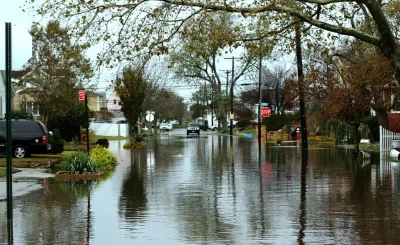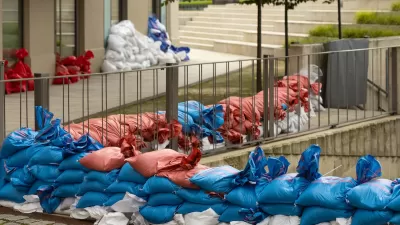Researchers from the University of Maryland and Texas A&M surveyed stormwater officials and synthesized the results. Their conclusion: "Rainwater is taking its toll on metropolitan America"

Slate staff writer Henry Grabar reports on a new study released on the threat posed by urban flooding:
It’s an anthropocene disaster, a manmade problem whose harms are decoupled from the Federal Emergency Management Agency’s floodplain maps, and from the risk awareness and preparation that goes along with that official warning. Many homeowners affected by flooding never thought they’d have to worry about it.
A new report by researchers at the University of Maryland and Texas A&M tries to assess the damage. “The Growing Threat of Urban Flooding,” released on Wednesday, surveys more than 300 stormwater officials and synthesizes the surprisingly scant body of knowledge. Rainwater is taking its toll on metropolitan America—but how do we measure it?
According to National Weather Service data, freshwater flood losses in the United States amount to nearly $8 billion a year over the past three decades—as if the damage from a very bad hurricane were spread throughout the country. Even during tropical cyclones, however, two in three flood insurance claims relate to freshwater flooding, not storm surge. Some flooding comes from swollen rivers or occurs on low-lying properties. But a surprisingly large degree of rainfall damage, based on local case studies, appears to be determined by manmade landscapes of asphalt, concrete, and iron. After scanning reports from local NWS field offices, the authors believe that the nation experienced some 3,600 urban flooding events in the past 25 years—about one every two to three days.
FULL STORY: How We Built Our Way Into an Urban Flooding Epidemic

Study: Maui’s Plan to Convert Vacation Rentals to Long-Term Housing Could Cause Nearly $1 Billion Economic Loss
The plan would reduce visitor accommodation by 25,% resulting in 1,900 jobs lost.

North Texas Transit Leaders Tout Benefits of TOD for Growing Region
At a summit focused on transit-oriented development, policymakers discussed how North Texas’ expanded light rail system can serve as a tool for economic growth.

Using Old Oil and Gas Wells for Green Energy Storage
Penn State researchers have found that repurposing abandoned oil and gas wells for geothermal-assisted compressed-air energy storage can boost efficiency, reduce environmental risks, and support clean energy and job transitions.

Santa Barbara Could Build Housing on County Land
County supervisors moved forward a proposal to build workforce housing on two county-owned parcels.

San Mateo Formally Opposes Freeway Project
The city council will send a letter to Caltrans urging the agency to reconsider a plan to expand the 101 through the city of San Mateo.

A Bronx Community Fights to Have its Voice Heard
After organizing and giving input for decades, the community around the Kingsbridge Armory might actually see it redeveloped — and they want to continue to have a say in how it goes.
Urban Design for Planners 1: Software Tools
This six-course series explores essential urban design concepts using open source software and equips planners with the tools they need to participate fully in the urban design process.
Planning for Universal Design
Learn the tools for implementing Universal Design in planning regulations.
Ascent Environmental
Borough of Carlisle
Institute for Housing and Urban Development Studies (IHS)
City of Grandview
Harvard GSD Executive Education
Toledo-Lucas County Plan Commissions
Salt Lake City
NYU Wagner Graduate School of Public Service




























